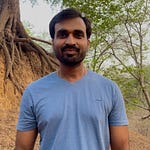The Tracking Indian Youth Attitudes Media Fellowship presents the next in a series of stories capturing the socio-political views and experiences of young people across India.
Professor Adarsh Mishra, 29 years old, teaches Hindi literature at Dr. Bhim Rao Ambedkar College. Adarsh’s academic journey spans some of India’s top institutions—earning a PhD from the University of Delhi for his work on poet Kedarnath Singh. Originally from Nebua Raiganj in Uttar Pradesh’s Kushinagar district, Adarsh brings both lived experience and critical insight to his role as an educator. In this candid conversation, he reflects on the evolving classroom, shifting student priorities, and the urgent need for curriculum reform.
“Over the past five years, we’ve produced nearly 1,000 new PhDs, but there are nowhere near enough jobs to accommodate them. Social media has reshaped their ambitions. When a student sees someone win ₹1 crore overnight on Dream11, the idea of spending years studying for a job that pays ₹25,000 or ₹50,000 a month seems unappealing. At 17 or 18, the world is your oyster. So the traditional model of education starts to feel like a waste of time in comparison.”
Read his full story below. Profile by Jyotsna Singh.
Jyotsna: Tell us about your early education. What was school like back in Kushinagar?
Adarsh: The school I went to was the only one in the area. Some students would cycle 10–12 kilometres in the morning to get there. It wasn’t a formal building but a shelter made of tin sheets and straw. But despite those conditions, the education was good.
Today, the area has 8 or 10 schools, including English-medium ones, and the infrastructure has improved significantly. But what’s missing is the soul of education. It’s become more about image, highlighting facilities and grades than about learning. The deeper purpose of education, to shape thinking and self-discovery, is slowly being lost.
Jyotsna: How has that shift affected students today?
Adarsh: There’s a noticeable lack of genuine curiosity. Many students, even at the college level, focus only on scoring marks. Learning has become performative. It’s less about understanding and more about getting through exams. In my six years of teaching, the biggest shift I’ve seen is post-COVID. Students seem less engaged. You see it in poor attendance, delayed assignments, and minimal participation. There’s a real drop in academic seriousness.
Jyotsna: Has online learning and internet accessibility contributed to that?
Adarsh: Definitely. COVID broke the rhythm of structured learning. At the same time, the internet made notes as well as full lectures instantly available. While that can be a resource, it’s also diluting the value of the classroom experience.
Add to that the awareness that job opportunities are limited. Over the past five years, we’ve produced nearly 1,000 new PhDs, but there are nowhere near enough jobs to accommodate them. Social media has reshaped their ambitions. When a student sees someone win ₹1 crore overnight on Dream11, the idea of spending years studying for a job that pays ₹25,000 or ₹50,000 a month seems unappealing. At 17 or 18, the world is your oyster. So the traditional model of education starts to feel like a waste of time in comparison.
Jyotsna: Doesn’t this show that current university education isn’t preparing students for good jobs, leading them to look elsewhere?
Adarsh: Change in our education system is too slow. I saw foreign universities teaching topics like selfies years ago. It might seem trivial, but it shows they’re willing to adapt to cultural shifts and contemporary relevance. If we keep using outdated syllabus, our students won’t be ready for the global market.
Jyotsna: But doesn’t the rising number of PhD admissions reflect increased interest in the subject?
Adarsh: On the surface, it looks like interest is rising. But if you look deeper, the reasons are different. Many students who complete their graduation or master’s in Hindi struggle to find jobs in the private sector, mainly because fluency in English is often a requirement. So their options become limited.
As a result, many of them see the PhD route as the only viable path to employment. For a lot of researchers, pursuing a PhD isn’t driven by a passion for academic research but more of a backup plan. Plan A is usually something else.
Jyotsna: Do you see a role for regional languages in this changing landscape?
Adarsh: We’re seeing a broader trend like in cricket commentaries, for example, are now being done in regional languages like Bhojpuri and Haryanvi. That tells us there’s a growing audience and demand for content in regional languages. So, languages like Tamil, Telugu, and Malayalam also need focused development and promotion.
The truth is, Hindi writers haven’t taken the language to the masses the way Shah Rukh Khan or Hindi cinema has. Globally, Hindi is known more through films than through literature. Our curriculum should reflect that. It should include cinema studies, sports writing, popular culture. Some changes have started: journalism has been added, there are cinema research centres now, but these updates are still too slow and not widespread enough.
Jyotsna: What would you say is the most urgent change Indian education needs today?
Adarsh: Many institutions still struggle with limited resources, even as student enrollment rises. We need more colleges and universities nationwide. A 1:20 teacher-student ratio would create a far better learning environment. Delhi University has plans to open two new colleges but that kind of expansion is essential across the country.
We need to bring meaning back into education. It can’t just be about marks or degrees. The system must evolve with the times. It needs to focus on adapting the curriculum, embracing regional languages, and expanding infrastructure. Only then can we create a space where both teachers and students grow, not just academically, but personally.
This is an ongoing series of profiles documenting the experiences of young people across India. Stay tuned for more stories from the youth of India. Follow us on social media for more updates.












Share this post